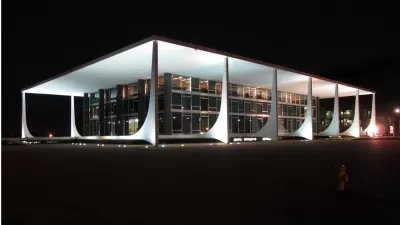Paul Goldberger offers a remembrance of the "last lion" of Modernism - Brazilian architect Oscar Niemeyer - who passed away earlier this week at the age of 104.
Niemeyer outlived his peers, worked until the last of his days, and through his 104 years, says Goldberger, "[h]is commitment to the notion that modernism could make life richer, freer, more spirited, and more meaningful also remained fully intact. You could call Niemeyer the last of the true believers, but he was more than that: an extraordinary blend of passion, arrogance, and naivety, seasoned, I suspect, with more than a little craftiness."
Of course, it's not possible to think of Niemeyer without the ties to his native country - he did after all design much of its futuristic new capital. As Goldberger explains, "Niemeyer was not just an architect who came from Brazil; he was Brazil, as much as Pele or the samba. His swirling forms and his curving lines replaced modernism’s harshness with softness and ease. Niemeyer didn’t compromise modernism’s utopian ideals, but when filtered through his sensibility, the stern, unforgiving rigor of so much European modernism became as smooth as Brazilian jazz. His work is sensuous, almost hedonistic."
And of his most famous creation, the controversial capital, Goldberger adds that, "Niemeyer lived long enough to see Brasilia admired, fall out of favor, and be admired again as a triumph of mid-20th-century design, which is how it ought to be seen—not as a model for how the world should live or how cities should be built, but as a thing unto itself, a fully realized product of a set of deeply held beliefs that, at least for a period, were shared by an entire national government."
FULL STORY: Remembering Oscar Niemeyer: The Architect Who Gave Modernism a Little Samba Flair

Alabama: Trump Terminates Settlements for Black Communities Harmed By Raw Sewage
Trump deemed the landmark civil rights agreement “illegal DEI and environmental justice policy.”

Study: Maui’s Plan to Convert Vacation Rentals to Long-Term Housing Could Cause Nearly $1 Billion Economic Loss
The plan would reduce visitor accommodation by 25% resulting in 1,900 jobs lost.

Why Should We Subsidize Public Transportation?
Many public transit agencies face financial stress due to rising costs, declining fare revenue, and declining subsidies. Transit advocates must provide a strong business case for increasing public transit funding.

Wind Energy on the Rise Despite Federal Policy Reversal
The Trump administration is revoking federal support for renewable energy, but demand for new projects continues unabated.

Passengers Flock to Caltrain After Electrification
The new electric trains are running faster and more reliably, leading to strong ridership growth on the Bay Area rail system.

Texas Churches Rally Behind ‘Yes in God’s Back Yard’ Legislation
Religious leaders want the state to reduce zoning regulations to streamline leasing church-owned land to housing developers.
Urban Design for Planners 1: Software Tools
This six-course series explores essential urban design concepts using open source software and equips planners with the tools they need to participate fully in the urban design process.
Planning for Universal Design
Learn the tools for implementing Universal Design in planning regulations.
Caltrans
Smith Gee Studio
Institute for Housing and Urban Development Studies (IHS)
City of Grandview
Harvard GSD Executive Education
Toledo-Lucas County Plan Commissions
Salt Lake City
NYU Wagner Graduate School of Public Service



























